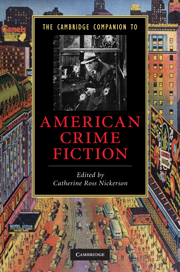Book contents
- Frontmatter
- 1 Introduction: The satisfactions of murder
- 2 Early American crime writing
- 3 Poe and the origins of detective fiction
- 4 Women writers before 1960
- 5 The hard-boiled novel
- 6 The American roman noir
- 7 Teenage detectives and teenage delinquents
- 8 American spy fiction
- 9 The police procedural in literature and on television
- 10 Mafia stories and the American gangster
- 11 True crime
- 12 Race and American crime fiction
- 13 Feminist crime fiction
- 14 Crime in postmodernist fiction
- Guide to reading
- Index
5 - The hard-boiled novel
Published online by Cambridge University Press: 28 September 2010
- Frontmatter
- 1 Introduction: The satisfactions of murder
- 2 Early American crime writing
- 3 Poe and the origins of detective fiction
- 4 Women writers before 1960
- 5 The hard-boiled novel
- 6 The American roman noir
- 7 Teenage detectives and teenage delinquents
- 8 American spy fiction
- 9 The police procedural in literature and on television
- 10 Mafia stories and the American gangster
- 11 True crime
- 12 Race and American crime fiction
- 13 Feminist crime fiction
- 14 Crime in postmodernist fiction
- Guide to reading
- Index
Summary
“Hard-boiled” is the style most people think of when they refer to the American crime story: tough-talking, streetwise men; beautiful, treacherous women; a mysterious city, dark, in Raymond Chandler's famous phrase, “with something more than night”; a disenchanted hero who strives, usually without resounding success, to bring a small measure of justice to his (or, more recently, her) world. The main elements of the style are so widely known that they have achieved something close to mythic stature. Merely invoking a few of its hallmarks is enough to plunge us into a deeply familiar world whose features seem to well up out of the dark recesses of the collective imagination.
That resonance at once illuminates and conceals the writing it surrounds. On the one hand, the sheer familiarity of its conventions points to the genuinely central place of the hard-boiled crime story in the popular culture of the United States. Along with a handful of comparable popular narratives, it is one in the repertoire of mass cultural codes whose rules are instantly recognizable and endlessly available for variation. On the other hand, the very familiarity of the hard-boiled style tends to over-inflate its prominence and to tie it too closely to a narrow idea of national character, while also obscuring the richness of the fiction itself. The once commonplace assumption that the American crime story simply is the hard-boiled story downplays the variety in the history of American crime narrative. It also threatens to reduce hard-boiled fiction to a kind of unauthored mythos, making it too easy to forget that the style emerged out of a distinct time and place and that it has been put to use by a number of talented artists who found in its elements the means to pursue quite varied ambitions.
- Type
- Chapter
- Information
- The Cambridge Companion to American Crime Fiction , pp. 42 - 57Publisher: Cambridge University PressPrint publication year: 2010
- 7
- Cited by



